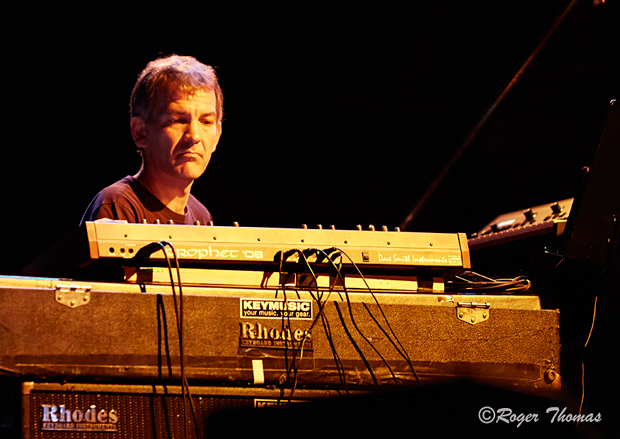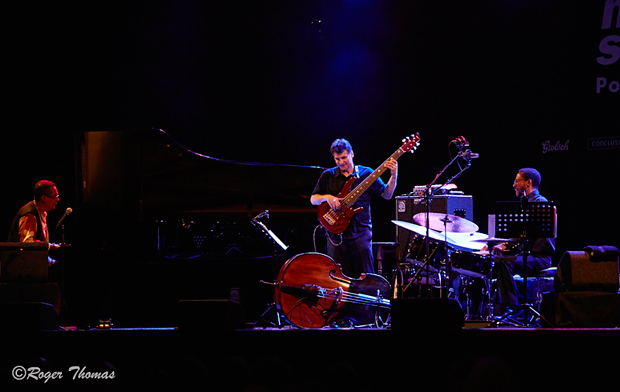Christian McBride, Mehliana and Pharoah Sanders make for epic North Sea Jazz Festival
Monday, July 21, 2014
With the proliferation of jazz festivals in recent times you would be less likely to raise an eyebrow if the programme from one of the newer promoters were to heavily featured non-jazz acts.

But, for a 39 year veteran such as the North Sea Jazz Festival, and particularly if your expectations lean more towards the mainstream then acts such as Robin Thicke or Pharrell Williams might well be considered as blurring the lines (pun intended) between what is, and what is not, jazz.
However, the NSJF's diverse programming is its strong point, held this year between 11-13 July, with 13 performance stages logistically positioned at the Rotterdam Ahoy complex, the bedazzling three-day timetable is big enough to allow you to map out a personal festival experience to your own liking or experimentation.
Entering the Ahoy is like being teleported into a musical theme park or village with music being performed at every corner. With great variety of eating and hanging out places such as Central Square also various retail outlets – should you wish to indulge in some festival merchandising therapy – the outside world becomes far removed from your existence. This festival village even has its own currency, the munten (or token) for purchasing all refreshments and culinary delights.
The Artist In Residence at this year's festival was Christian McBride (pictured top), which saw several featured performances by him on each day. A jazz bassist of formidable ability and reputation he performed in various settings; big band, small combo and with his regular trio of Rodney Green (drums) and Christian Sands (piano).
Robert Glasper's Experiment featuring Lalah Hathaway and Bilal were one of the first acts to set things rolling. Together with the Metropole Orkest their musical statement blends and crosses the boundaries of jazz, gospel, R&B, hip hop with a tinge of classical. Even the most conservative listener could endorse their rendition of Stevie Wonder’s 'Jesus Children of America' as something special. However, if 1970-80s funk also happens to be your thing, a dash across to the large Nile Arena and you could get your dose from the Parliament-Funkadelic and ex-James Brown bass man Bootsy Collins who showed a strident determination to 'tear the roof off the sucker'! Wielding a sparkling star-shaped bass guitar he would occasionally turn to face his spacesuit clad Funk Unity Band to summon up more theatrics, much to the delight of the audience.
In stark contrast Mavis Staples brought a sobering sanity to the Congo Stage with her gospel/blues tinged performance. The band laid down a soulful foundation complementing her smooth yet assertive tone on 'Respect Yourself’, which gave the song an authentic stamp redolent of the original Staple Singers.
Pharoah Saunders creates a meditate mood in the Hudson hall with Oli Hayhurst (bass), Gene Calderazzo (drums) and William Henderson (piano). A long surging intro by the rhythm section to John Coltrane's 'Crescent' where Saunders weave his tenor sax motifs before a sweeping crescendo into the melody. This alone was ample confirmation of being at a jazz festival and for you to sit back into your chair assured of a joyful performance.

Brad Mehldau (keyboards/samplers - pictured above) and Mark Guiliana (drums/electronic gadgets) jointly know as Mehliana performed a mix of electronica fusing jazz, funk, prog rock to a captivated audience, which at times seems serious. As usual at the NSJF diversity can always be found not too far from the mainstream. In the Nile Arena following on from the Robin Thicke performance, Pharrell Williams draws a crowd that fills the arena conjuring up visions of sardines in a can. Surprisingly people found room to sway and dance when he performed the chart topper he co-wrote with the rapper Nelly, 'It's Getting Hot In Here'.
Day 2 saw Quincy Jones being honoured in the Amazon Auditorium with the Metropole Orkest Big Band, conducted by Jules Buckley they performed lush arrangements from the Jones catalogue. Later on in the day Quincy himself, presented his 'Global Gumbo Project' featuring the young Cuban pianist Alfredo Rodriguez, singer Nikki Yanofsky (who also appeared at the Love Supreme Festival) and Hungarian child prodigy, guitarist Andreas Varady. Quincy extolled their virtues as encouragement for each to do their best and for the audience to be impressed by his young protégés. Based on their performances no doubt we will be hearing more from them in the future.

Children Of The Light Trio (Danilo Perez, piano, John Patitucci, bass and Brian Blade, drums - pictured above) showed that they can conjure up musical magic without their mentor, Wayne Shorter. Their collective virtuosity gives them identity as they flow through genres and influences from Pan-American Latin, to classical and American jazz, though there are moments you anticipate Shorter will appear out of nowhere with a crowning embellishment.
Hammond organist Dr. Lonnie Smith with his guitar and drums trio show they can groove as well as take you to the outer edges of harmony incorporating synthesisers and electronic gadgetry. But it's Benny Golson with his poignant relating of the history behind each song played that really transforms the atmosphere of moderately sized Madera room to that of a cosy nightclub. His tribute to trumpeter Clifford Brown through his much-covered composition 'I Remember Clifford' was both beautiful and touching.
Surprisingly other artists such as French-Lebanese trumpeter Ibrahim Maalouf, Sons Of Kemet, singer Chloe Charles et al drew decent sized audiences, bearing testament to the strength of their musical offerings. It was surprising by the fact that Stevie Wonder's performance overlapped theirs. Such was Wonder’s attraction that the 15,000-plus capacity Nile Arena’s main entrances had to be closed with audience spilling over into the outer eating areas where it was an equal struggle to be able to view the show from various overhead cinema screens. Typically, Mr Wonder infused the mood with his wonder and closed the day where he held the audience spellbound for a marathon two-and-a-half-hour set where he also invited a gleeful Joss Stone onto the stage where they engaged in ad lib vocal exchanges.

Day 3 kept the momentum going with great performances and feats of showmanship from Charles Bradley, Sharon Jones and the Daptone Super Soul Revue. Natalie Cole’s performance added a svelte sophistication to the mix and Cécile McLorin-Salvant (above) shows that the defining styles of past songstress (Holiday, Fitzgerald, Vaughan) remain fresh as well as timeless whilst pianist John Escreet with his trio featuring Evan Parker on saxophones showed that you can have form without melody and hold on to an audience.
A tough act to follow after Stevie Wonder's Day 2 closing performance, it was 90s hip-hop duo Outkast who would perform the closing act of the 2014 festival. It might be assumed that the ethos for their performance was one of trying to go out with a bang and perhaps the deafening sound was their way of trying to keep up with Mr. Wonder though not a convincing substitute. However, for the vast crowd it seemed to appeal that the jazz festival would end with no jazz as the performed popular hits such as ‘Ms Jackson’, ‘Roses’, ‘So Fresh So Clean’ and ‘Rosa Parks’.
Whatever, no one would imagine the festival promoters being disappointed with much this year as numbers in attendance made this the biggest ever NSJF, with tickets being completely sold out as it remains the biggest jazz festival in the world. There are so many to choose from these days but if you like your jazz festivals to be as a ‘festival on steroids’ and you also have a good amounts of sustaining energy then this is the one for you.
– Roger Thomas (story and photos)